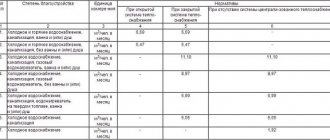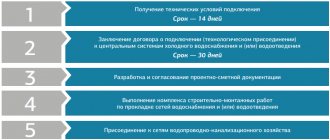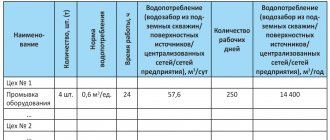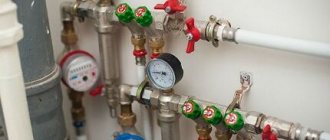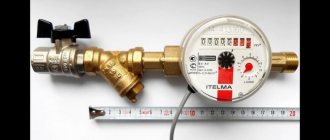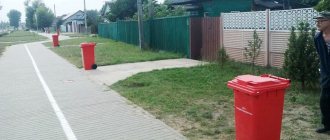Arrangement of communications during the construction or modernization of a house is a rather complex and responsible process.
Already at the design stage of these two important engineering systems, it is necessary to know and strictly follow the rules of water supply and sanitation in order to avoid future operational problems and conflicts with environmental services.
In our material we will try to understand these rules, which are difficult at first glance, and will tell our readers why a water meter is needed and how to correctly calculate the volume of water consumption.
How is the rate of water consumption per person calculated?
To determine approximately how much water a resident of an apartment building consumes, the following factors must be taken into account:
- consumption standards that apply in any region of Russia;
- consumption standards set by local authorities;
- how much water (according to the meter) does a family with the same number of people use?
It was mentioned above that the standard is set depending on the region of residence of a person; accordingly, the time of year also affects the volume of water consumption: in summer – higher, in winter – lower.
If the apartment has working household appliances and plumbing fixtures (economical faucet, toilet flush tank, etc.), a person saves water, and accordingly, the consumption rate can be reduced.
The consumption of liquid, on the contrary, increases when the equipment leaks water, the faucet or toilet tank leaks. If this fact is identified and documented by an employee of a housing organization, the consumption rate per person may be increased.
People pay for cold and hot water supply according to tariffs set by local authorities.
In apartments where metering equipment is not included, the cost of consumed water is calculated as follows:
- instead of readings from an apartment water meter, average water consumption in the house is taken (separately for hot and cold water);
- multiplied by the tariff per cubic meter;
- and, if available, take into account the increasing factor.
How to calculate how much water residents of a private house consume
Note that it is not easy to calculate how much water a person living in a private house uses.
In addition to the fact that water is used for personal needs (hygienic procedures, laundry, washing dishes, cooking, etc.), the owner needs to water the green spaces adjacent to the house - garden, vegetable garden. Water consumption increases if a private house has a swimming pool and other amenities of civilization.
Correctly calculating the volume of water consumption in a private home is possible only at the design stage. It is also necessary to consider what technology and equipment the tenant uses.
Noticed:
- if you continuously use water for an hour, a person will consume about six cubic meters of liquid;
- watering green spaces adjacent to the house requires about two cubic meters of water;
- When watering a garden, a summer resident spends up to four cubic meters of liquid in one hour.
These data are approximate, calculated for houses with standard equipment and regular utilities.
From physical activity.
The more we exercise, the more fluid we use - this is a known fact for all experienced and novice athletes. If there is at least some physical activity in your life, then this is necessarily reflected in the amount of fluid consumed. Before classes, during classes and after – it is necessary to drink liquid and you cannot ignore the body’s requirements for replenishing moisture reserves.
How can you reduce costs for water supply and general house needs when installing meters?
Most ordinary people express the opinion that without water metering devices per person, monthly obligatory payments for an apartment exceeded all expectations. Installation of equipment is carried out at the expense of the apartment owner, but in the end he receives an undeniable benefit.
In residential buildings equipped with one central riser, several meters can be installed: hot and cold water supply. In multi-apartment buildings with two risers, you will have to install 4 devices: respectively, two for hot water supply, two for cold, while the volume of work is greater, the tariff will be slightly higher.
Counters for cold and hot water
Relationship between water consumers and service provider
By entering into a contractual relationship with a water supply and sewerage organization, you become a consumer of water supply/sewage services.
Your rights as a user of the service provided:
- demand from the supplier the continuous provision of appropriate services (standard water pressure, its chemical composition safe for life and health);
- apply for the installation of water meters;
- demand recalculation and payment of penalties if the service is not provided in full (the act must be drawn up within 24 hours after submitting the application);
- terminate the contract unilaterally, but subject to 15 days notice and full payment for the services received;
The subscriber has the right to receive payment information (personal account status) free of charge.
No water or barely flowing? Call the dispatch service and request the arrival of a representative of the water utility to draw up a report
List of rights of the second party:
- stop (with a few days' prior notice) the supply of water and the collection of wastewater, in whole or in part, if the technical condition of the water supply networks and sewerage systems is unsatisfactory;
- require access to the client’s territory to take readings of water meters, check seals, and inspect water supply and sewer systems;
- carry out preventative maintenance according to schedule;
- turn off water to debtors;
- stop water supply without warning in case of accidents, natural disasters, or power outages.
Disputes and disagreements are resolved through negotiations or in court.
Hot water standard per person 2021 in the Moscow region
08.04.2018
At the same time, municipal authorities can change the indexation percentage based on the well-being of their own budgets. In Moscow, the rate of tariff growth remains traditionally one of the highest. Utility consumption standards 2021 are a quantitative indicator of the volume of consumption of such resources:
Water standards 2021 in Moscow
The provided calculations are subject to careful verification by authorized specialists, any discrepancies are recorded in the protocol, and then approved by the relevant Order for each company with mandatory consideration of fixed marginal cost increase indices for the period from July 1 of the next calendar year to June 30 of the plan year.
Rules for calculating the cost of a cubic meter of water The tariff for cold water includes resource costs for its provision to the direct user, namely: Housing and communal services tariffs increase annually, the basis for the increase is the increase in prices for various resources (fuel, reagents, material and technical equipment) for cleaning, supply and water drainage.
We recommend reading: When is transport tax calculated?
Consumption and consumption rates of hot and cold water per person per month without a meter
Payments for residents' consumption of hot and cold water are calculated according to the readings of special metering equipment. However, in their absence, calculations are carried out in accordance with the standards established by regional authorities.
And for water drainage it is generally impossible to keep records using any equipment.
So its calculation is carried out either according to consumption standards, or based on the volume of service consumed - but the second option without metering devices is not applicable.
Standard consumption of hot water and cold water per person in 2021
Standards for the consumption of utility services, approved by the Tariff Department of the Novosibirsk Region for 2021. According to formula 4 (1) of Appendix 2 to the Rules for the provision of utility services (Resolution of the Government of the Russian Federation No. 354, hereinafter referred to as the Rules) to standard charges for utility resources in residential premises where there is no individual metering device for the corresponding utility resource, an increasing factor of 1.5 is applied.
We recommend reading: Where to See the Queue for an Apartment in Moscow
Water consumption without metering devices: norms, tariffs, calculation
Washing dishes requires up to 12 liters per day, and washing requires consumption of up to 100 liters. If the house is private, you also need to take into account such an important expense item as watering the lawn or other area of the site with plantings. This work also requires a large volume of liquid.
Standard water consumption without a meter per person in 2019
- to flush the toilet cistern 118 times, 6 liters each = 710 liters;
- to take a bath 4 times 250 liters = 500 hot and 500 liters cold;
- take 25 showers of 100 liters = 1250 hot and 1250 liters cold;
- to use the kitchen sink 95 times, 8 liters each = 380 hot and 380 cold;
- for washing clothes and washing floors 31 times, 8 liters = 50 hot and 200 cold;
- using the sink for hygiene purposes (brushing teeth, washing hands) 107 times, 20 liters each = 1070 hot and 1070 cold.
Standard for hvs one person
As for the technical feasibility of installing a meter, there are certain criteria under which this process becomes impossible: Minimum consumption standards for certain types of housing and communal services The validity period of the standards issued by the Government must last at least 3 years, with the exception of only some cases. They can be changed under the following circumstances: making appropriate amendments to the current Rules; The room parameters and climate become different; if there is a need for recalculation using the analogue method, if the previously established value was calculated based on the formula.
Hot water standard per person 2021 in the Moscow region Link to main publication
How much water does a person need per day
According to many experts, the norm for human water consumption per day is 1.5 liters. The “8 glasses” rule is popular among fitness club trainers. However, it is difficult for many to get used to such standards, and some doubt that this displacement is the same for everyone.
And they do the right thing: the required amount of water is different for all people and it depends on many factors.
This includes, in addition to 1.5 liters of clean drinking water, liquid that enters the body with food, including compotes, fresh juices and dairy products. Also, every day approximately 300 ml of fluid is formed in the human body due to biochemical reactions.
How is the norm of drinking water per person per day determined?
How to determine the amount of water needed
As mentioned above, there are many factors that need to be taken into account to find out how much water a particular person needs to drink per day.
The main ones are:
- Gender. Since men have more muscle tissue, which consists of 70-80% water, than women, their need for fluid is greater and amounts to 2 liters. Women sweat less than men, so the average daily water requirement for them is 1.5 liters.
- Activity and body weight. A person’s daily need for water increases if he is actively involved in sports or physical labor - it can reach 3 liters or even more.
- Also, the required water consumption is adjusted according to the person’s weight: 30-40 g of water is needed per 1 kg. For those who play sports, there is a special American drinking regimen. According to it, during training you need to take 3-5 sips of water every 15-30 minutes. And at the end of the workout, it is advisable to drink the amount of water corresponding to the weight loss.
- Seasonality. Of course, in winter the body requires much less water than in summer. But even if you absolutely don’t want to drink, you need to do this to avoid dehydration, the signs of which are drowsiness, weakness, brittle nails, and dry skin.
In order to feel good in the summer, you need to constantly replenish the lack of moisture. The water consumption required to maintain water balance increases with increasing air temperature. So, if at 21°C 1.5 liters of water are needed per day, then at 32°C – 3 liters.
From the environment.
It is a well-known fact that if you live in a hot climate, then you need to drink more water. In addition, regardless of the climatic conditions of the region, we must not forget that in the hot season it is necessary to increase the dose of liquid by approximately 25-30%. In winter, it is equally important to replenish body fluids. This is due to the fact that the humidity level outside drops to almost zero unless there is a period of rain. In addition, in a room where it is heated all the time in winter, humidity levels also drop to zero.
Of course, special devices for regulating room humidity are an excellent option, but we must not forget about sufficient fluid intake during such periods. Why is this so important? Due to a lack of moisture in the body, skin problems are possible: dryness, roughness, flaking, changes in the functioning of the sebaceous glands, as well as deterioration of metabolism in the body.
Consumption standards for hot water and cold water per citizen
The standard for hot water in apartments was determined in 1988. Instead of IPU, then they used a single meter at the entrance, connected to the water supply pipes in the basement. Therefore, some residents paid more than they consumed, others less, and the concept of “saving water” was unfamiliar.
The calculation of the standard indicator was entrusted to the Ministry of Construction. To do this, we analyzed the life of the average citizen, calculating the number and volume of cases of water consumption.
These included:
- personal hygiene – how many times the consumer takes bath procedures;
- average number of toilet flushes;
- washing, cooking;
- use of sinks in the kitchen and bathroom.
Water consumption standards according to SNiP 2.04.01-85
DHW consumption standard
According to statistical information, a citizen consumes about one hundred liters daily. Consequently, the monthly consumption of hot water per person according to the standard is about 3000 liters. DHW used in the heating system is not included in this article, so the fee is charged additionally.
With and without counter
Based on the fact that the cost of heated water is higher and consumption is lower, the lack of a measuring device has a greater impact on the budget.
This is influenced by the following features of payment calculation:
- If there is a shortage, the Criminal Code has the right to recalculate. This leads to doubling, i.e. the hot water standard per person will be considered x2.
The final figure is 4.7 cubic meters. The actual consumption, with rare exceptions, is much lower. Hence the obvious benefit of installing a DHW IPU.
Cold water consumption standard
Cold water is consumed more often and in larger quantities, so the ratio for it is higher, i.e. 200 liters per day, 6000 monthly. The result is about 6.9 cu. meters.
You can calculate cold water consumption based on estimated costs:
- shower and bath – 210 and 200 liters per week;
- toilet – about 200 liters daily;
- hygiene procedures - another 200 liters weekly.
The rest relates to the kitchen sink, washing, cleaning, unnecessarily open faucets, and so on.
With an individual device and without IPU
The consumption standard for cold water supply takes into account emergency situations and usually high consumption is associated with them. Because of this, the objective indicator has to be overestimated. In some cases, installing a cold water meter is not always as beneficial as it is obviously beneficial in relation to a hot device. However, the owner of an apartment in an apartment building under normal circumstances does not spend the entire monthly allowance.
How much extra money is going down the drain?
Average consumption of hot water and cold water per citizen per month
Typically, consumption does not exceed the limits established by the legislator. The rate of hot water consumption per person per day ranges from 14 to 140 liters, cold water - from 30. Therefore, in most cases, installing the device will be more profitable, even if you do not save resources.
It is difficult to take into account the average for two reasons - individual figures for regions of the country and most regions. Consumption is strongly influenced by climate conditions, since in the North the consumption of hot water is higher. Additionally, the season matters.
Factors influencing the average consumption of hot water and cold water:
- the presence of a bathroom - in its absence, the shower cabin spends much less;
- connection to a central water supply system to heat water instead of using a heater;
- household appliances – “dishwasher”, “washing machine”.
The value varies depending on the condition of the plumbing, but the impact is more visible over an annual period. Faucets that require repair or replacement produce noticeable leaks, while modern faucets save budget and resources.
Program for calculating water consumption: Water consumption
This is a small program specially made for calculating water consumption.
Select “Calculation of hot water and cold water consumption”
Select the type of consumer:
And provide additional information for each consumer
After adding a consumer, you can add more consumers and then go to the Calculated values tab and see the result of the calculations:
In general, the program is not complicated. Everyone can understand it.
The values obtained with the WaterCalculations program are similar.
Download the program for calculating water consumption
Online calculator for calculating water consumption
Use your colleagues. Count quickly and correctly.
Source
Ways to save your budget when paying for water
It’s definitely not possible to reduce your water bill without a meter. Consumption will be calculated based on standard values and the number of residents registered in the apartment. So the main solution to the problem of saving is to install the device.
You can save on water by stopping wasting it and equipping your home with modern household appliances. For example, with the help of an economical washing machine or dishwasher, the daily consumption rate will be reduced by almost half. And with the help of the habit of periodically turning off the tap while brushing your teeth, shaving, washing dishes - by another 10%.
It is recommended to update all pipes and plumbing. The slightest deformation can lead to leakage, which means increased consumption. Faucets should be repaired if they are dripping. Better yet, replace everything with lever ones. They are 15-20% more economical than valve ones (according to research by specialists).
To streamline payments, building cooperatives, condominiums and management companies install common building meters in their entrances. They help determine the total volume consumed by all residents. As a rule, the amount consumed in apartments with meters is then subtracted from it, and the remainder is divided among the remaining residents.
Is it profitable to install meters?
For some reason, there is a widespread belief among the population that after installing a meter, you will have to pay many times more for water. This is only true for individual cases when a large family uses water. In other situations, the total consumption recorded by the meter is always significantly less than the standard values. Therefore, you need to pay less. Not to mention other obvious advantages:
- no need to pay for excess consumption of other residents of the house;
- payment receipts are issued exclusively for the actual volume of water resources spent, which eliminates the need to pay for those periods when no one lived in the apartment;
- the increasing factor is automatically canceled;
- it becomes possible to monitor water consumption and take measures to reduce it.
In total, a family of 4 people can reduce the cost of paying for cold, hot water and waste water by 1.5-2 times a month after installing the meter. And at the same time, pay for what she actually spent, and not for what the Management Company or Housing Authority blindly calculated.
Without a metering device, you must pay for water consumption in accordance with the standards established in the region. They are different for different types of resources and can be adjusted in each individual subject of the Russian Federation. Installing a water meter will help reduce the cost of water consumption. As well as other measures aimed at the proper use of water resources.
Standard for hot water supply per 1 resident by city
The data is based on approved standards for residential buildings with central hot water supply for residential premises equipped with bathrooms. It should be noted that not every region takes into account the size of bathtubs, as determined by government regulations.
| Cities and regions | General water standard, m3 | DHW norm, m3 |
| Moscow | 11,68 | 4,75 |
| Saint Petersburg | 2,43 | |
| Krasnodar region | 6,69 | 2,65 |
| Volgograd region | 9,95 | 4,4 |
| Novosibirsk | 10,65 | 4,36 |
| Ekaterinburg | 8,86 | 4,01 |
| Kazan | 3,44 |
The table shows that the norms in individual regions and cities differ by almost 2 times. And if, with a standard of 2 m3/person, you want to refuse metering, then with 4 m3/person, it is better to install a meter. This is especially encouraged by the increasing coefficient.
Standard hot water per person per month
In order to set hot water standards for a month, the regional government must allocate statistical research. On this basis, both N is assigned - the regional standard for the consumption of cold or hot water supply, and T - that is, the regional tariff. In 2021, the transition to a two-component payment for hot water supply began.
Saving options
Now the consumer will pay every month not for a cubic meter of hot water already received, but for the cold water consumed and the energy spent on heating it.
Water is heated in different ways, supplied from a heat source located in the house, or centrally. All this will be taken into account in the monthly payment and will inevitably lead to an increase in tariffs.
This payment system was planned to be introduced at the beginning of 2019. However, it became relevant on July 1, and by 2021 all suppliers will switch to a two-component payment option.
Hot water standards do not depend on how the consumer pays. Each person in a given entity can consume from 2.5 to 4.7 cubic meters. hot water. The consumption rate depends on the region of the consumer.
Daily consumption by country
In Moscow, they pay more for water consumption than in any other region. But it is impossible to definitively answer how much the Moscow region pays. It all depends on the locality and the method of water supply.
It is interesting that in a private house, if a person does not install a water meter, a fixed cubic capacity is certainly assigned based on watering the garden. You don’t have to grow anything on the plot, but in the absence of a meter, payment will be made for a hypothetically existing subsidiary plot.
Average value for hot water in 2021
The average statistical norm for hot water consumption per person in Russia is 166 liters per day, and cold water consumption is much higher, approximately 233 liters.
Adviсe
But the average Russian is an abstract concept, so there are regional norms and nuances of calculation. When a meter exists, the costs of maintaining an apartment building are added.
For MBDOU and hospital institutions, taking into account their specifics, this figure may be increased. For those who have installed the meter, there is an additional prerogative. You can save on real monthly consumption and the discrepancy between standards.
Factors affecting throughput
The main factor used to calculate the pipeline system is throughput. This indicator is influenced by many different parameters, the most significant of which are:
- pressure in the existing pipeline (in the main network, if the pipeline under construction will be connected to an external source). The calculation method taking into account pressure is more complex, but also more accurate, since an indicator such as throughput, that is, the ability to pass a certain amount of water in a certain unit of time, depends on pressure;
- total pipeline length. The larger this parameter, the greater the amount of losses that appears during its use and, accordingly, to avoid a pressure drop it is necessary to use pipes of larger diameter. Therefore, this factor is also taken into account by specialists;
- the material from which the pipes are made. If metal pipes are used to construct a water pipeline or other main line, then the uneven internal surface and the possibility of gradual clogging with sediment contained in the water will lead to a decrease in throughput and, accordingly, a slight increase in diameter. When using plastic pipes (PVC), polypropylene pipes, the possibility of clogging with deposits is practically eliminated. Moreover, the inner surface of plastic pipes is smoother;
Reduced pipe capacity due to deposits
- pipe section. Based on the internal cross-section of the pipe, you can independently make a preliminary calculation.
There are other factors that are taken into account by experts. But for this article they are not significant.
Calculating water costs in multi-apartment residential buildings
Each person consumes a different amount of water per day. It can be calculated using the formula:
Volume per day per person = value of the estimated number of inhabitants * value of specific water consumption / 1000
In addition, there are adjustment factors for residents of cities with larger and smaller populations.
In order not to clutter people's heads with unnecessary numbers and indicators, a consumption standard has been created, which is taken into account when paying utility bills. When there is no metering device, charges are made based on the number of officially registered residents
If, for example, a water heating device is installed in the apartment, excess water costs for this equipment are distributed equally among all registered ones. Accordingly, the more residents are registered, the higher the payment for water supply and sanitation will be.
Is it possible to reduce water costs?
If apartment residents delay the installation of water meters, unnecessary expenses are unlikely to be avoided. Standards are set for each house separately, or the average water consumption is calculated based on data from a separate microdistrict.
You can invite every resident of a high-rise building who does not have a water meter not to waste excess water, but it is unlikely that everyone will agree to follow this rule.
Sometimes people try to prove in court that the introduction of an increasing coefficient is unfounded, but in practice, few achieve the desired result.
Some residents install special devices that save water. But even such “tricks” do not affect the numbers indicated on the receipt. This is because charges are made based on the number of people registered in the apartment.
The best way to reduce this cost item is to install a liquid consumption meter. Then you will pay only for those cubic meters that you actually spent. No one will look at the number of people registered in a given territory, and no one will have to pay for the water consumed by a neighbor.
Legitimate Ways to Reduce Water Use
To save as much water as possible, you must adhere to the following rules.
Install devices that allow you to save money. These include:
- special nozzles for taps;
- aerators, which are placed on shower heads and thus reduce water consumption;
- two-button drain systems that are equipped with barrels.
If there are appliances or plumbing fixtures in your home that are leaking water, they need to be repaired as a matter of urgency. This applies to:
- a dishwasher that is out of order and constantly leaks;
- continuously dripping faucets;
- a toilet bowl into which water flows in a thin stream, etc.
It wouldn’t hurt to get a modern model of washing machine. In addition to high-quality washing, such an “helper” will save money. To wash clothes, the machine takes half as much water as older automatic machines.
Those who want to save money will have to introduce new habits:
- turn off the tap if you are not using water (for example, when soaping dishes with detergent, lathering in the shower, while brushing your teeth, etc.);
- give preference to bathing in the shower, i.e. fill the bathtub with water in rare cases;
- reduce the time of “water procedures”.
Sometimes people do not use hot water at all or save it with the help of a stove - they heat the liquid as needed.
Advantages and disadvantages of a water meter
On this issue, people's opinions differ. At first glance, the benefits may seem obvious:
- a resident of an apartment building will not have to pay for water used by residents of other apartments;
- it becomes possible to independently control water consumption;
- payment upon delivery - if water is not consumed by a person during the day or month (for example, the tenant went on vacation), accordingly, there is no need to pay anything;
- There are no increasing factors, payment is made according to the current tariff.
But sometimes people remain dissatisfied after installing a water meter. This happens if one person is registered in the apartment, but relatives constantly come to him and stay for a long time, i.e. in fact, more people live there.
It should be noted that such “reviews” are isolated, and in most cases, installing a meter allows you to save considerable amounts. The installation of such a device is not cheap, however, some “pay for” the installation of the device in a matter of months.
In any case, the choice remains before the resident of an apartment building or a private building. And if a person is satisfied with the established standards for water consumption, no one can force him to install a water meter.
What you should pay attention to when checking water meters:
Scope of influence of the regulatory document
“Rules for cold water supply and sanitation” is the full name of the document approved on July 29, 2013 under N 644. Last edition – April 2021, changes and additions are valid from April 12, 2018.
The rules define the relationship between subscribers (consumers of services) and organizations that supply them, based on the conclusion of binding contracts.
Concluding an agreement for the supply of water and sewerage will not take much time if you collect a full package of necessary papers in advance
The document also discusses:
- consumers of services - individuals, budget organizations, enterprises, etc.;
- algorithm for connecting objects to central systems (central systems);
- accounting of released water, accounting of diverted wastewater, quality control;
- consumers who are required to take into account the discharge of wastewater into the central heating system using measuring instruments;
- calculation of compensation for the discharge of excessively polluted wastewater, the procedure for informing about changes in their composition and properties (submission of declarations);
- standards, a mechanism for monitoring their use in practice, determining the amount of excess payment;
It must be thought out and provided, and if necessary, access to the subscriber’s water supply and sewerage communications, to the points of water and wastewater sampling must be created.
Image gallery
Photo from
Water supply and wastewater systems
Ensuring adequate water supply
Relationship between water supply and sewerage
Installation of an industrial drainage system
The role of water in the human body
In the aquatic environment, first of all, all metabolic, biochemical processes and metabolism occur. Scientists have found that water in a newborn makes up 90 percent of the total mass, in an adult – 70...80 percent. The critical point is 55 percent of body weight of water: this is precisely its percentage in the body of a person who dies of old age. Therefore, it turns out that when they say a person “has shrunk,” this is not a metaphor at all, but a sad reality. The main ways water enters the human body are:
- in the form of liquids (regular drinking water, mineral water, juices, etc. - up to 1.2 liters);
- with food products (fruits, vegetables, meat products, bread, seafood and much more - up to 1 liter);
- is formed naturally in the body (as a result of physiological and biochemical processes - up to 0.3 liters).
The main ways of removing water from the human body are:
- through the kidneys (up to 1.2 liters);
- with sweating (up to 0.85 liters);
- through breathing (up to 0.32 liters);
- through the intestines (up to 0.13 liters).
Water Source Possibilities
are the only factor that is in no way under the control of either the home owner or the utility designer. If the flow rate of a well or well is low, then the total daily water consumption in the house will depend on it. After all, residents will be able to use only the amount that the source can provide. It makes no sense to install a more powerful system and focus on the “desired” water supply calculation: you will have to come to terms with it and learn to save water.
This article uses images from paduiblog.com, migrelief.wordpress.com, udachnyi.com
Comment on FB Comment on VK
About carrying out computational actions
Correct selection of the system becomes possible provided that the main water flow for a particular building is known. Each plumbing or household appliance has a connection to the water supply network and its own average flow rate. It is already taken into account by the program used.
In the required fields, you should indicate for which devices the water will be purified. You just need to check the boxes next to these devices. In this situation, the option of an ordinary house, devoid of any additional frills, is taken into account.
The probability of all water points operating at the same time is not very high, but theoretically possible. In this regard, a special coefficient has been introduced into the computer program, which makes it possible to make certain adjustments. To do this, you must specify the maximum number of water consumption points.
In the technical data sheet of filtering systems, the throughput can be reflected in three measurement options, so the final result is given in all of them at once. This is necessary to simplify further actions.
Save time: selected articles delivered to your inbox every week
Source
